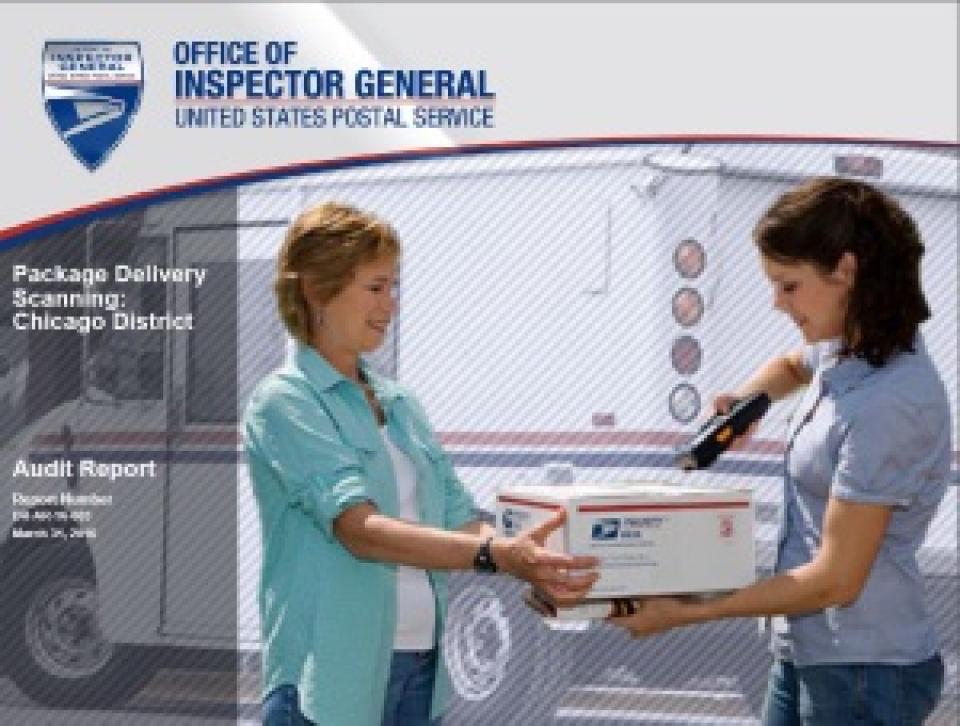Package Delivery Scanning: Chicago District
Background
The U.S. Postal Service’s goal is to scan all of its barcoded mailpieces (flats, letters, and packages) that enter the mailstream. The Postal Service wants to achieve 100 percent visibility and provide world-class package delivery services to be increasingly competitive. The Postal Service measures package delivery service performance based on its acceptance through the first attempt to deliver.
When a carrier attempts to deliver a package, it gets a stop-the-clock scan, indicating the Postal Service has completed its commitment to deliver or attempt to deliver the package. Delivery unit management uses the End of Day report to monitor stop-the-clock scans. The report identifies packages received at delivery units each day that did not receive a stop-the-clock scan.
City carriers must perform stop-the-clock scans for packages at the point of delivery. They use a handheld Mobile Delivery Device (MDD), which uses a cellular network and Global Positioning System technology to obtain real-time delivery tracking information. If a mobile delivery device is not available, carriers can use an Intelligent Mail® Device, the predecessor to the MDD; however, the Intelligent Mail Device does not provide Global Positioning System data or real-time delivery tracking information.
The OIG learned through its Office of Investigation about possible delivery scan falsifications in the Chicago District. Subsequent data analysis and reviews of customer posts on social media sites confirmed that some delivery scans in the Chicago District could be false.
The Chicago District has 48 city delivery units and 2,126 routes. From October 1, 2014, through July 31, 2015, the district scanned over 20 million packages. Using scan data, we judgmentally selected 30 sites for review. These 30 sites delivered 75 percent of packages scanned in the district (or 15.4 million packages) and received 33,071 customer complaints related to package delivery scanning.
Our objective was to assess the package scanning process for city delivery operations in the Chicago District.
What the OIG Found
Our analysis of the 30 delivery units showed opportunities exist to improve the Chicago District’s package scanning process in city delivery operations. Specifically, we found 10,181 packages that were falsely scanned as delivered even though the carrier had not left the office. We found an additional 71,434 packages that were scanned either before the carrier left the office or after the carrier returned. However, we were unable to definitively determine how many of them were falsely scanned because some were designated as Caller Service (a fee-based optional delivery service) to be picked up by a customer at the office rather than being delivered to a customer’s location and the scans were not specific enough to determine delivery type. In addition, we found 296,219 packages with delivery scans and no location data, so it was impossible to determine if the required scans were performed at the point of delivery.
These issues occurred due to:
- Insufficient supervision of city delivery operations.
- Carriers not following proper procedures.
- The lack of a specific scan designated for packages associated with Caller Service.
- Unfilled supervisor vacancies.
- Scans improperly performed at the end of day to clear reports of non-delivered packages.
- Insufficient number of MDDs for all routes.
- Scan devices experience Global Positioning System signal obstruction due to tall buildings, trees or other physical interference with Global Positioning System signals.
Customers rely on accurate data to track their packages in real time. By improving scanning operations, district management can potentially save money and receive fewer customer complaints related to the location and delivery status of their package. When scans are inaccurate, customers can become dissatisfied and lose confidence in the Postal Service’s ability to meet their shipping needs.
What the OIG Recommended
We recommended the vice president, Delivery Operations, establish a specific scan designated for Caller Service packages to differentiate these scans from false scans.
We also recommended the vice president, Great Lakes Area, coordinate with the vice president, Delivery Operations, to repair or obtain additional MDDs; reinforce to delivery unit managers the importance of adhering to guidelines for properly securing relay mail, scanning packages, and supervising delivery operations; fill vacant supervisor positions within 6 months; and provide guidance to delivery unit management on proper use of the End Of Day report and communicating issues to district management for resolution.

